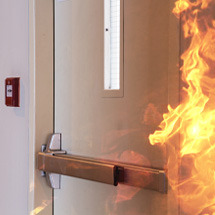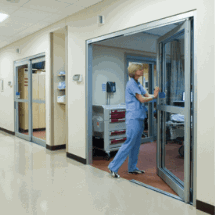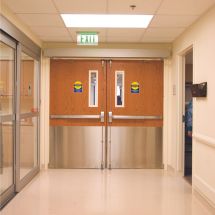How Do Handicap Door Openers Work?
October 19, 2021
Handicap door openers are a necessary installation for many business owners. Not only are they a courteous way to make your business accessible to everyone, but they are often also required by local law (depending on where you live). In this article, we’re taking a look at how these doors work, and what to do if you’re experiencing any issues.
Handicap doors are doors that operate via a push button, or automatically. They are designed to meet the special requirements of anyone with mobility issues.
Most models of handicap doors automatically open upon the press of the button, and remain open for an appropriate amount of time, allowing those with mobility issues to pass through the doors. They can also operate automatically via a motion sensor. The doors also need to be designed in accordance with width and size requirements, ensuring that anyone in a wheelchair (or other mobility devices) can utilize the door properly.
Exact regulations for handicap doors may differ depending on where you live, but they are usually similar. Regulations include a button that is affixed at an appropriate height and in an appropriate location (solid ground) to be reachable by those who are sitting down. There are also regulations that mandate the door be an acceptable width for those in wheelchairs (commonly at least 32 inches). Additionally, the laws usually mandate a threshold height of no more than ½ inch, to allow those in wheelchairs or those with mobility issues to easily pass over.
Of course, opening normal doors can be quite difficult for many people who live with disabilities or any mobility issues, and a handicap door is a very courteous way to accommodate these needs.
A traditional handicap door operates via a button-press (although there are other varieties, which we’ll cover below). The button is attached in a position that is accessible to those with mobility issues. Once the button is pressed, a signal is sent to the door itself. Usually, there is a mechanical arm affixed to the top of the door, which is triggered to swing open the door. The arm remains open long enough for the door to be used and closes the door behind the user.
An “automatic door” is a broader category of a door, and handicap doors usually fit into this category (provided they meet the legal requirements otherwise). Automatic doors are an effective way to accommodate all users, and often provide more ease-of-access than a button-press handicap door. Most automatic doors utilize motion sensors, eliminating the need for a button-press. Automatic doors are generally much more expensive to install.
Of course, the cost of a handicap door opener varies depending on the specifics of the project. It may depend on the size of the door, the location you are buying materials/labour, and the type of handicap door you want to install.
Purchasing and affixing a button-press handicap door opener costs on average $2200. A typical range of prices is between $2000 and $3000. Note that this does not include the cost of purchasing and installing the door itself. The price depends on the cost and quality of the handicap door system you purchase, and whether you pay someone to have it installed. The installation will usually be priced at an hourly rate and will include the time to set-up, install the components, and clean up the site. Depending on whether the door itself is already installed, this will be a more or less expensive process.
The handicap door openers themselves vary in price depending on quality and functionality. Of course, we recommend purchasing a quality unit that is built to withstand many uses. This is especially important in the case of a business, where many will be entering and leaving your premises on a regular basis.
There are a few types of handicap-suitable door openers to choose from besides the traditional button-press system. The right choice for you may depend on your individual needs, local regulations, and whether you require a handicap door for business or personal use. The main categories of handicap doors include:
Thanks very much for reading our guide to handicap door openers. As you can see, there are many types of handicap door openers available. If you are thinking about purchasing a handicap door for your business, you need to be aware of the regulations in your area. Consider the information above to have your handicap door installed the right way and also hire a AAADM certified technician.
Q: How do you change the battery in my handicap door button?
A: Replacing the battery in your handicap door button is quite simple but might differ depending on the exact device. There are usually screws affixed to the button’s faceplate. Remove the screws, and you’ll gain access to the battery box (which might have additional screws you’ll need to remove). Then, simply replace the battery with the acceptable type.
Q: Can you install a handicap door opener yourself?
A: Yes if you have the necessary skills, training and expertise. But do note that these door openers need to be installed in strict accordance with your local laws and regulations (ADA Regulations in the United States). For these reasons, we recommend hiring a AAADM certified technician. Improperly installing a handicap door can present issues for your business, and for anyone with mobility issues who attempts to use the door.
Q: Do you need a separate closer for handicap doors?
A: Often, the answer is yes, but it depends on the model of the door opener. Some door openers require an opener and closer to be installed on separate sides of the door, to “push” the door from either side. Without a closure mechanism, some systems will remain open until they are closed manually. This can also present a separate issue because the exterior door is exposed to the elements. Many door-closers are rated to withstand severe weather for this reason.
What are Handicap Doors?
Handicap doors are doors that operate via a push button, or automatically. They are designed to meet the special requirements of anyone with mobility issues. Most models of handicap doors automatically open upon the press of the button, and remain open for an appropriate amount of time, allowing those with mobility issues to pass through the doors. They can also operate automatically via a motion sensor. The doors also need to be designed in accordance with width and size requirements, ensuring that anyone in a wheelchair (or other mobility devices) can utilize the door properly.
Exact regulations for handicap doors may differ depending on where you live, but they are usually similar. Regulations include a button that is affixed at an appropriate height and in an appropriate location (solid ground) to be reachable by those who are sitting down. There are also regulations that mandate the door be an acceptable width for those in wheelchairs (commonly at least 32 inches). Additionally, the laws usually mandate a threshold height of no more than ½ inch, to allow those in wheelchairs or those with mobility issues to easily pass over.
Of course, opening normal doors can be quite difficult for many people who live with disabilities or any mobility issues, and a handicap door is a very courteous way to accommodate these needs.
How do push-button handicap door openers work?
A traditional handicap door operates via a button-press (although there are other varieties, which we’ll cover below). The button is attached in a position that is accessible to those with mobility issues. Once the button is pressed, a signal is sent to the door itself. Usually, there is a mechanical arm affixed to the top of the door, which is triggered to swing open the door. The arm remains open long enough for the door to be used and closes the door behind the user.
How do Automatic door openers work?
An “automatic door” is a broader category of a door, and handicap doors usually fit into this category (provided they meet the legal requirements otherwise). Automatic doors are an effective way to accommodate all users, and often provide more ease-of-access than a button-press handicap door. Most automatic doors utilize motion sensors, eliminating the need for a button-press. Automatic doors are generally much more expensive to install.
How much does it cost to install a handicap door opener?
Of course, the cost of a handicap door opener varies depending on the specifics of the project. It may depend on the size of the door, the location you are buying materials/labour, and the type of handicap door you want to install. Purchasing and affixing a button-press handicap door opener costs on average $2200. A typical range of prices is between $2000 and $3000. Note that this does not include the cost of purchasing and installing the door itself. The price depends on the cost and quality of the handicap door system you purchase, and whether you pay someone to have it installed. The installation will usually be priced at an hourly rate and will include the time to set-up, install the components, and clean up the site. Depending on whether the door itself is already installed, this will be a more or less expensive process.
The handicap door openers themselves vary in price depending on quality and functionality. Of course, we recommend purchasing a quality unit that is built to withstand many uses. This is especially important in the case of a business, where many will be entering and leaving your premises on a regular basis.
Types of handicap door openers
There are a few types of handicap-suitable door openers to choose from besides the traditional button-press system. The right choice for you may depend on your individual needs, local regulations, and whether you require a handicap door for business or personal use. The main categories of handicap doors include:
- Per ANSI 156.19 ADA Operators must have a “Knowing Act” to Operate the Door.
- Button-Press: Similar to the traditional handicap door we examined above. The button triggers a mechanical arm attached to the top of the door, which opens and shuts the door automatically. Depending on the model, the opener and closer might need to be installed on opposite sides of the door. You might find options with different shaped buttons, and these can operate via a battery or through an outlet.
- Remote Door Opener: A remote door opener is more suitable for residential use because the user requires the remote to open the door. Often people use this technology for garage doors. The remote sends a signal to a receiver, which triggers the mechanical mechanism to open the door. Some handicapped users install the remote directly onto their wheelchairs.
- Door Handle: There are also non-mechanical options available. These are more suitable for residential use (because they don’t have ADA compliance) and might be more suitable for those with better mobility. Handicap door handles come in different shapes and sizes to meet the needs of those with differing mobility issues. They are usually larger, easier to grip, and don’t require as much effort to open. They are often shaped like door levers because these can be opened by simply applying pressure to one side. Another advantage is that these are more affordable than any options above, which might make them more suitable if your budget is lower.
Conclusion
Thanks very much for reading our guide to handicap door openers. As you can see, there are many types of handicap door openers available. If you are thinking about purchasing a handicap door for your business, you need to be aware of the regulations in your area. Consider the information above to have your handicap door installed the right way and also hire a AAADM certified technician.Frequently Asked Questions
Q: How do you change the battery in my handicap door button?
A: Replacing the battery in your handicap door button is quite simple but might differ depending on the exact device. There are usually screws affixed to the button’s faceplate. Remove the screws, and you’ll gain access to the battery box (which might have additional screws you’ll need to remove). Then, simply replace the battery with the acceptable type.
Q: Can you install a handicap door opener yourself?
A: Yes if you have the necessary skills, training and expertise. But do note that these door openers need to be installed in strict accordance with your local laws and regulations (ADA Regulations in the United States). For these reasons, we recommend hiring a AAADM certified technician. Improperly installing a handicap door can present issues for your business, and for anyone with mobility issues who attempts to use the door.
Q: Do you need a separate closer for handicap doors?
A: Often, the answer is yes, but it depends on the model of the door opener. Some door openers require an opener and closer to be installed on separate sides of the door, to “push” the door from either side. Without a closure mechanism, some systems will remain open until they are closed manually. This can also present a separate issue because the exterior door is exposed to the elements. Many door-closers are rated to withstand severe weather for this reason.





